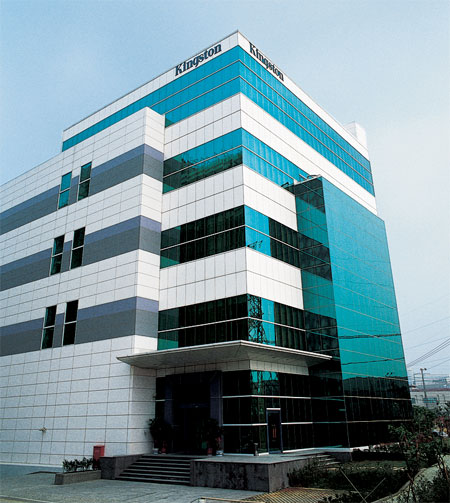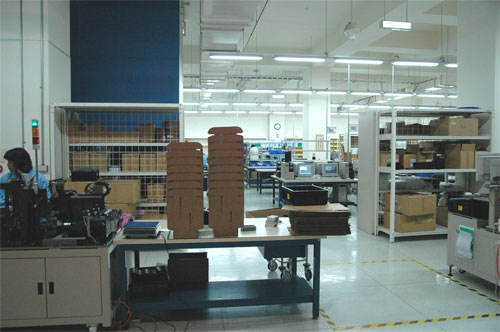World Wide Memory: A Tour of Kingston Taiwan
by Wesley Fink on June 16, 2005 12:05 AM EST- Posted in
- Memory
Headquartered in Fountain Valley, California, Kingston is by far the world's largest independent memory manufacturer. From its beginnings in 1987, Kingston has grown to a 27% market share in 2004 and almost $2.5 Billion in sales - which is more than 3 times larger than #2. Perhaps even more important was the 35% growth in revenue for Kingston from 2003 to 2004.
Kingston today manufactures memory at four manufacturing locations: US, Malaysia, China, and Taiwan. The four manufacturing plants have more than 35 Surface Mount Technology (SMT) lines for producing virtually every kind of memory available in the world. This includes the DIMMs, So-DIMMs, and flash memory that are of most interest in the Computer and Digital Imaging markets. Within these product categories, Kingston manufactures a full range of products, from OEM parts to their popular Value RAM series to Enthusiast-oriented Hyper X products.
Since we were in Taiwan for Computex, Kingston kindly invited AnandTech to take a closer look at their Taiwan manufacturing facility.
Kingston Taiwan is a memory assembler, which means that finished memory chips are shipped to the plant where they assemble the memory using SMT technology. There are no wafer manufacturing capabilities in the Taiwan plant.
Kingston today manufactures memory at four manufacturing locations: US, Malaysia, China, and Taiwan. The four manufacturing plants have more than 35 Surface Mount Technology (SMT) lines for producing virtually every kind of memory available in the world. This includes the DIMMs, So-DIMMs, and flash memory that are of most interest in the Computer and Digital Imaging markets. Within these product categories, Kingston manufactures a full range of products, from OEM parts to their popular Value RAM series to Enthusiast-oriented Hyper X products.
Since we were in Taiwan for Computex, Kingston kindly invited AnandTech to take a closer look at their Taiwan manufacturing facility.


Kingston Taiwan is a memory assembler, which means that finished memory chips are shipped to the plant where they assemble the memory using SMT technology. There are no wafer manufacturing capabilities in the Taiwan plant.











48 Comments
View All Comments
Backslider - Thursday, June 16, 2005 - link
@15I'm sure the author just used the wrong term. for the process. There is no way they could use wave soldering on SMT parts, it has to be reflow.
Son of a N00b - Thursday, June 16, 2005 - link
great article...thanks!Brazos - Thursday, June 16, 2005 - link
I can't believe they don't use a automated test machine. Load a stack of dimms in and the machine loads them, tests them, records results, kicks out bad ones. Loading by hand into a pc is so 70's :)Houdani - Thursday, June 16, 2005 - link
I would be surprised if they actually use wave solder to "glue" the parts down. It is more likely they use some form of reflow technique such as infrared, convection, or vapor phase.Wave solder is used for leaded parts, but reflow makes more sense for SMT parts -- and as far as I can tell, Kingston doesn't have any leaded parts (parts with legs which poke through the circuit board) on their DIMMs or flash products (SD, CF, et al).
Regs - Thursday, June 16, 2005 - link
How exactly do all those one's and zero's copy themselves into the ram? That's what I want to know.yacoub - Thursday, June 16, 2005 - link
awesome article!Anyone else want to grab a case of completed DIMMs and turn it into a giant RAM disk? :D
xsilver - Thursday, June 16, 2005 - link
#11they said they test them -- not run memtest for 24 hours -- they also said that now their competition is also doing the same thing....
its feasable but kingston is not much of a player in the enthusiast market theses days
gibhunter - Thursday, June 16, 2005 - link
I smell BS. There is no way they test millions of manufactured memory sticks by hand in a computer. Yeah, they may do some testing of random sticks but there is just no way that they do this to all of them. Maybe they just test the ones that are suspect after the machine test, but to test them all would require more man power than it takes to make them. Their prices then would be much higher than their competition and that's not true either.semo - Thursday, June 16, 2005 - link
yeah i guess you're right Wesley, we all need a break from theinquirer and such sometimes...i still think that they can let you in some stats like how much do the machines cost, how often they’re replaced, mtbf, throughput ...
maybe a video of how the machines do their job next time and why not tweak them (while the daemon guards with the lightning whips are not looking) to make them dance?
Brian23 - Thursday, June 16, 2005 - link
I got excited seeing the QA Engineer in action.